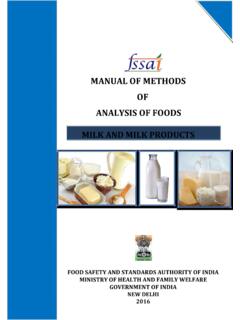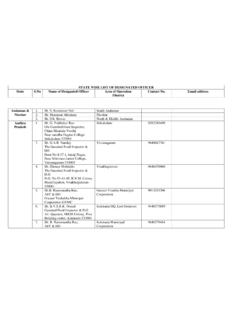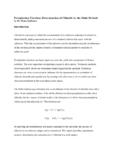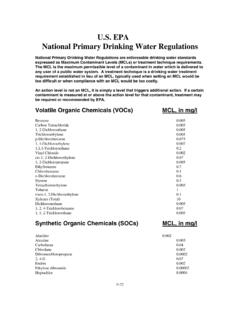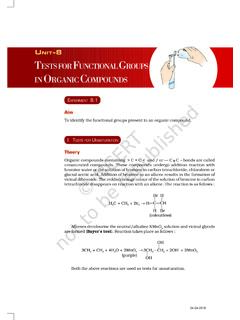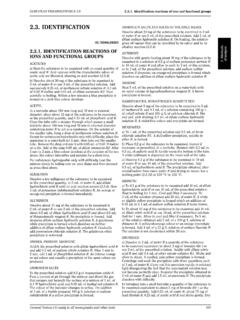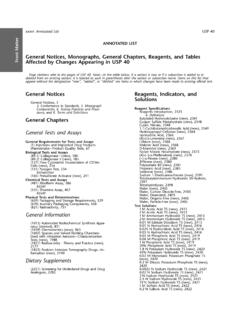Transcription of MANUAL OF METHODS OF ANALYSIS OF FOODS - FSSAI
1 MANUAL OF METHODS . OF. ANALYSIS OF FOODS . FRUIT AND VEGETABLE PRODUCTS. food SAFETY AND STANDARDS AUTHORITY OF INDIA. MINISTRY OF HEALTH AND FAMILY WELFARE. GOVERNMENT OF INDIA. NEW DELHI. 2016. FRUIT AND VEGETABLE PRODUCTS 2016. MANUAL FOR ANALYSIS OF FRUIT AND VEGETABLE PRODUCTS. TABLE OF CONTENTS. S. NO. TITLE/METHOD PAGE NO. Thermally Processed Fruits and Vegetables 1. (Canned). Thermally Processed Fruits and Vegetable Juices, 10. Fruit Beverages, Fruit Drink, Fruit Nectars and Non Thermally Processed Beverages (canned, Bottled etc). Thermally Processed Fruit Drink, Beverages, Pulp, Juice, 33. Puree (Canned, Bottled Poly packed). Soup Powders 34. Tamarind Pulp, Puree, Concentrate 35.
2 Fruit Bar / Toffee 36. Fruit and Vegetable Cereal Flakes 38. Squashes, Crushes, Fruit syrups, Sherbets, Ginger Cocktail 39. Murabba 39. Candied, Crystallised, Glazed Fruit / Vegetable, Fruit Peel 41. Mango Chutney 41. Tomato Ketchup, Sauce, Culinary Paste 42. Soya bean Sauce 42. Brewed and Synthetic Vinegar 43. Carbonated Fruit Beverages, Drink 50. Jam, Jelly and Marmalade 50. Dehydrated Fruits and Vegetables 51. Pickles 55. Table Olives 55. Dried Fruits and Vegetables 55. References 56. Note: The test METHODS given in the manuals are validated/ standardized test METHODS . However, it would be the responsibility of the respective testing laboratory to confirm that the above METHODS are validated in its laboratory and gives proper result in their laboratory.
3 FRUIT AND VEGETABLE PRODUCTS 2016. MANUAL FOR ANALYSIS OF FRUIT AND VEGETABLE PRODUCTS. Standards for processed fruits and vegetables are laid down in section of food Safety and Standards ( food Product Standards and food Additives) Regulations, 2011 and include thermally processed fruits and vegetables, fruit and vegetable juices, soups (canned/bottled/flexibly packed), soup powders, dehydrated vegetables, fruit jam/ jelly/ marmalade/ fruit cheese, squashes, sherbets, chutneys, pickels etc. the standards for dried fruits and nuts are given in section (raisins, pistachio nuts etc.). 1. THERMALLY PROCESSED FRUITS AND VEGETABLES (CANNED/BOTTLED/. FLEXIBLY PACKAGED). Physical examination: Note the external condition of the can such as rusty spots, body dents, scratches, leakage around seams, condition of the ends etc.
4 The external condition of the can is described in terms such as: a) FLAT (both ends concave). b) FLIPPER (a mechanical shock producing distortion in one end or both ends). c) SPRINGER (one end is distorted while other end is flat) and d) SWELL (both ends convex). Determination of Vacuum: Place the pointed end of the vaccum gauge in the middle of the top plate of the can and press firmly to pierce the can. Note down the vaccum in millimeters of mercury (Ref: - ISI Hand book of food ANALYSIS (Part 1) 1980 page 2). Fill of Container: Principle: This method determines the percent total volume of a container occupied by the 1. FRUIT AND VEGETABLE PRODUCTS 2016. contained food . It is designed primarily for cans but can be used for wide mouth glass containers also.
5 Apparatus: Head space Gauge One can be conveniently made from a straight edge a small ruler. Procedure: Open the container (use a can opener for cans and remove lid for jars) and measure the distance from the container top to the food using the headspace gauge. This is usually done at the center but if the food surface is uneven, then make several measurements at different points and average them. Pour out the food over a sieve to determine drained weight. Wash, dry and weigh the container. Fill the container with water to within 5 mm of the top (using the head space gauge). Weigh the container and water. Next draw off water from the container until the water is at the same level as measured for the food .
6 Again weigh the container and water. (Note that the water temperature should be the same during both weighings). Calculation: The % fill of the container = W2 T X 100. W1 - T. Where T = Weight of empty container W1 = Container plus water, first weight W 2 = Container plus water, second weight (Ref: - FAO Manuals of food Quality Control 14 / 8 page 184). 2. FRUIT AND VEGETABLE PRODUCTS 2016. Drained weight: : The sample is drained on a standard mesh sieve. The weight of the material remaining on the sieve is expressed as percentage of the can contents. Apparatus: Sieve with square openings, mm x mm (No. 6 ). Use a sieve of 20 cm if the total weight of contents is under kg and of 30 cms if the weight is more than kg.
7 Table for sieve size Method Capacity of Sieve Diameter, Mesh opening, Draining container mm mm time, min Canned fruits a. Less than 20 X 2. and vegetables 850 mL. b. Above 850 30 X 2. mL. Canned a. Less than 20 X 2. tomatoes 850 mL. b. Above 850 30 X 2. mL. Other 20 X 5. Products in Sauce Procedure: Weigh the full can. Open and pour the entire contents on a circular sieve. Without shifting the product, incline the sieve to facilitate drainage. In the case of products with a cavity such as peach halves, invert if necessary, so that the liquid can drain through the cavity but otherwise the product should not be disturbed. Drain for two minutes. 3. FRUIT AND VEGETABLE PRODUCTS 2016. Weigh the drained solids and the empty can.
8 Drained weight % drained weight = ------------------------------- x 100. Net weight of contents Net wt. of contents = Gross weight tare weight of the can. For canned tomatoes use a sieve with square openings of mm x mm. For products in sauce, use a sieve with square openings of mm x mm;. Wash the contents on the sieve with water until free of adhering substances. Spread on sieve and drain for 5 minutes, dry the underside of the sieve and weigh. (Ref: - FAO Manuals of food Quality Control 14 / 8 page 183 / Codex Alimentarious Commission Recommended method 36 / 7 1970, and method 44 1972). Internal condition of the can: Examine the internal surface for any corrosion, pitting, scratching, defects in lacquering, leakages, discolouration, detinning etc.
9 Determination of soluble solids: Principle: Measurement of the refractive index of the test solution at 200C, using a refractometer, and use of tables correlating refractive index with soluble solids content (expressed as Sucrose), or direct reading of the soluble solids content on the refractometer. 4. FRUIT AND VEGETABLE PRODUCTS 2016. Apparatus: a) Refractometer - indicating the refractive index by means of a scale graduated in , in order to allow readings to be estimated to Refractometer - indicates the percentage by mass of Sucrose by means of a scale graduated in %, in order to allow readings to be estimated to %. This refractometer shall be adjusted so that at 200C it registers for distilled water a soluble solid (Sucrose) content of zero.
10 The distilled water refractive index at 200C is b) Water circulating apparatus - to maintain the temperature of the prisms of the refractometer constant to within 0 C in the neighbourhood of 200C which is the reference temperature. If the temperature of circulating water is different from 200C. use temperature correction as per table on page no. 8. c) Beaker- capacity 250 mL. Procedure: Preparation of test solution: (a) Clear liquid products: Thoroughly mix the sample and use it directly for determination. (b) Semi thick products (purees etc.): Thoroughly mix the sample. Press a part of the sample through a gauge/muslin cloth folded in four, rejecting the first drops of the liquid and reserving the remainder of the liquid for the determination.
